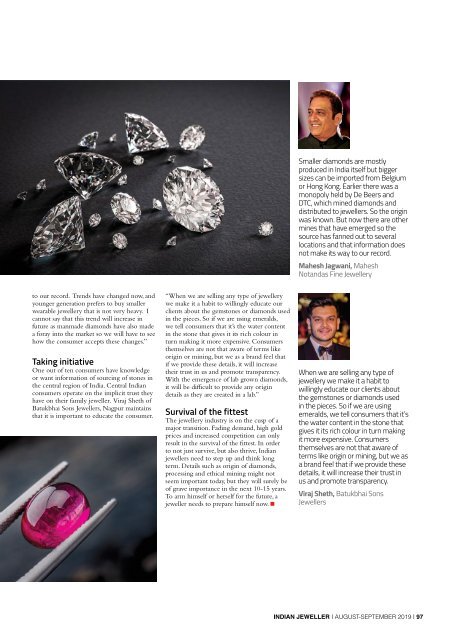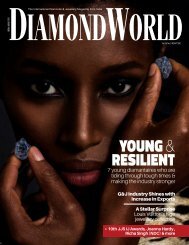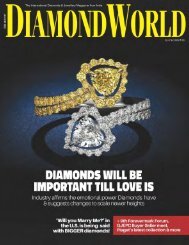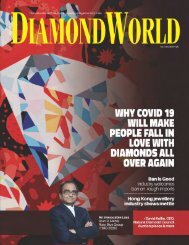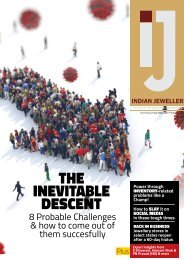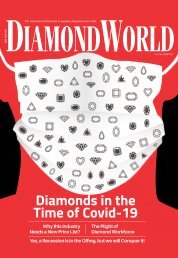Indian Jeweller (IJ) Magazine August -September 2019
Volume 10 | Issue 1 August September 2019
Volume 10 | Issue 1
August September 2019
You also want an ePaper? Increase the reach of your titles
YUMPU automatically turns print PDFs into web optimized ePapers that Google loves.
Smaller diamonds are mostly<br />
produced in India itself but bigger<br />
sizes can be imported from Belgium<br />
or Hong Kong. Earlier there was a<br />
monopoly held by De Beers and<br />
DTC, which mined diamonds and<br />
distributed to jewellers. So the origin<br />
was known. But now there are other<br />
mines that have emerged so the<br />
source has fanned out to several<br />
locations and that information does<br />
not make its way to our record.<br />
Mahesh Jagwani, Mahesh<br />
Notandas Fine <strong>Jeweller</strong>y<br />
to our record. Trends have changed now, and<br />
younger generation prefers to buy smaller<br />
wearable jewellery that is not very heavy. I<br />
cannot say that this trend will increase in<br />
future as manmade diamonds have also made<br />
a foray into the market so we will have to see<br />
how the consumer accepts these changes.”<br />
Taking initiative<br />
One out of ten consumers have knowledge<br />
or want information of sourcing of stones in<br />
the central region of India. Central <strong>Indian</strong><br />
consumers operate on the implicit trust they<br />
have on their family jeweller. Viraj Sheth of<br />
Batukbhai Sons <strong>Jeweller</strong>s, Nagpur maintains<br />
that it is important to educate the consumer.<br />
“When we are selling any type of jewellery<br />
we make it a habit to willingly educate our<br />
clients about the gemstones or diamonds used<br />
in the pieces. So if we are using emeralds,<br />
we tell consumers that it’s the water content<br />
in the stone that gives it its rich colour in<br />
turn making it more expensive. Consumers<br />
themselves are not that aware of terms like<br />
origin or mining, but we as a brand feel that<br />
if we provide these details, it will increase<br />
their trust in us and promote transparency.<br />
With the emergence of lab grown diamonds,<br />
it will be difficult to provide any origin<br />
details as they are created in a lab.”<br />
Survival of the fittest<br />
The jewellery industry is on the cusp of a<br />
major transition. Fading demand, high gold<br />
prices and increased competition can only<br />
result in the survival of the fittest. In order<br />
to not just survive, but also thrive, <strong>Indian</strong><br />
jewellers need to step up and think long<br />
term. Details such as origin of diamonds,<br />
processing and ethical mining might not<br />
seem important today, but they will surely be<br />
of grave importance in the next 10-15 years.<br />
To arm himself or herself for the future, a<br />
jeweller needs to prepare himself now.<br />
When we are selling any type of<br />
jewellery we make it a habit to<br />
willingly educate our clients about<br />
the gemstones or diamonds used<br />
in the pieces. So if we are using<br />
emeralds, we tell consumers that it’s<br />
the water content in the stone that<br />
gives it its rich colour in turn making<br />
it more expensive. Consumers<br />
themselves are not that aware of<br />
terms like origin or mining, but we as<br />
a brand feel that if we provide these<br />
details, it will increase their trust in<br />
us and promote transparency.<br />
Viraj Sheth, Batukbhai Sons<br />
<strong>Jeweller</strong>s<br />
INDIAN JEWELLER | august-september <strong>2019</strong> | 97


